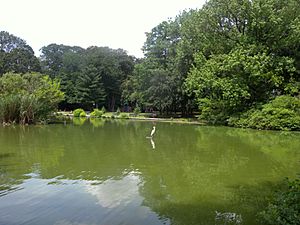Captain Tilly Park facts for kids
Quick facts for kids Captain Tilly Park |
|
|---|---|

Goose Pond, Captain Tilly Park
|
|
| Location | Jamaica, Queens, New York, US |
| Area | 9.16 acres (3.71 ha) |
| Operated by | New York City Department of Parks and Recreation |
| Open | 6 a.m. to 1 a.m. |
| Status | open |
Captain Tilly Park is a 9.16-acre (3.71 ha) park in Jamaica Hills, Queens, New York. It's located north of downtown Jamaica. The park has a special pond called Goose Pond. This pond is the only one of its kind left in Jamaica Hills.
The land for the park used to belong to the Tilly family. They gave it to New York City in 1908 to be a park. At first, it was called Highland Park, then Upland Park. In 1935, it was renamed Captain Tilly Park. This was to honor George H. Tilly, a local hero who died in the Spanish–American War. Over the years, the park and its pond have been fixed up many times. The New York City Department of Parks and Recreation takes care of the park.
Contents
What is Captain Tilly Park Like?
Captain Tilly Park is about 9.16-acre (3.71 ha) big. It's in Jamaica Hills, a neighborhood in Queens. The park is surrounded by streets like 165th Street and 85th Avenue. Jamaica High School is right next to the park. The New York City Department of Parks and Recreation (NYC Parks) manages the park.
There's a playground in the park, perfect for kids to have fun. You can also find restrooms in the park.
Goose Pond: The Park's Heart
Goose Pond is a 2-acre (0.81 ha) lake right in the middle of Captain Tilly Park. It's known as the park's main feature. This pond is a "kettle pond." This means it formed naturally in a dip in the land left by melting glaciers long ago.
Goose Pond is also home to a small bird sanctuary. It's called "the smallest island in the smallest natural body of water" in New York City. In the past, people loved to ice-skate on the pond in winter. A natural spring under the pond was found in 1980. Later, in the 1990s, the pond was updated with seven artificial jets to keep the water moving.
How Captain Tilly Park Was Made
Early Days of the Park
The land where Captain Tilly Park now stands was once owned by the Tilly family. The park was first known as Highland Park. Around 1891, a group called the Highland Park Society was formed. Their goal was to create a park and playground for Jamaica.
In 1908, the Tilly family sold the land to the city for just $1. They had one condition: it had to stay a park forever. The park's name was changed to Upland Park in 1912. This was to avoid confusion with a bigger park in Brooklyn. The city later bought more land to make Upland Park even bigger.
In 1925, the city officially took ownership of the park. Goose Pond was drained in 1926 because Jamaica High School was being built nearby. The city wanted to expand the park along with the school. However, some people in the community thought the costs were too high. After several years, a judge lowered the payments for the land.
Renaming and First Renovations
In 1935, the city decided to rename the park "Captain Tilly Park." It was dedicated that August. The park was named after Captain George H. Tilly. He was a local hero who died in the Spanish–American War in 1898.
With the new name came new improvements. The park got new benches and lights. The landscaping was made better, and Goose Pond was made deeper. At this time, the park was about 7.75 acres (3.14 ha) big. A monument honoring heroes of the Spanish-American War was put in the park in 1941.
Fixing Up the Park
By the 1970s, many trees in the park were dying. The park looked worn out. In 1971, NYC Parks set aside money for repairs. The city planned to fix the park in the mid-1970s. However, a financial problem in New York City in 1975 caused delays.
A special grant helped the renovation project get more money in 1978. But by December of that year, people in the community were upset. They felt NYC Parks wasn't doing enough to start the work. The pond had so little water that people couldn't ice-skate for the first time in 75 years. It was also becoming a health concern.
Finally, the park renovation started in 1980. Workers planted new trees and installed new benches and lights. They cleaned the ponds and repaved the paths. The playground was also replaced.
In the late 1980s and early 1990s, people wanted Goose Pond to be fixed again. The pond had too much algae, which was harming the fish. The city put aside $455,000 for a cleanup in 1993. Work began in 1995. Seven underwater air pumps were added to the pond to keep the water moving.
In 1998, NYC Parks added thousands of fish and other water creatures to the pond. A few weeks later, some fish were found dead. The renovation was finished in early 1999 and cost $700,000. However, some residents reported more algae problems soon after.
NYC Parks started another big renovation of Captain Tilly Park in 2014. This project cost $2.4 million. The first part involved fixing paths and equipment. The second part focused on removing plants that didn't belong in the pond. In 2020, NYC Parks also planned to rebuild the park's restrooms.


